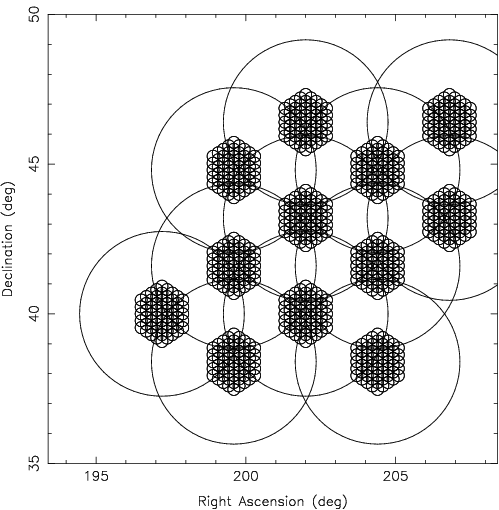
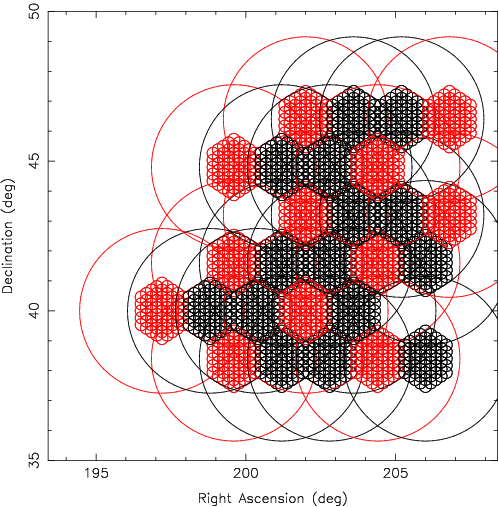

LOTAAS confirmed discoveries
| # | Pulsar | P (ms) | DM (pc/cc) | Single pulse | Confirmation | Localization | Discovery date | Notes |
| 2019 (1) | ||||||||
| 74 | J1958+21 | 1050 | 87.7 | Oct 30, 2019 | beam 19 | Sep 2, 2019 | First FFA discovery! | |
| 2018 (7) | ||||||||
| 73 | J0827+53 | 13 | 23.1 | Dec 7, 2018 | beam 10 | Nov 28, 2018 | MSP binary! | |
| 72 | J1333+09 | 911 | 23.9 | Aug 25, 2018 | beam 23 | Aug 20, 2018 | found in 2 adjacent beams | |
| 71 | J1303+38 | 396 | 19.0 | Aug 24, 2018 | beam 37 | Jul 23, 2018 | found in 3 adjacent beams | |
| 70 | J1706+35 | 159 | 19.2 | Jun 4, 2018 Jun 19, 2018 | beam 3 beam 26 | May 23, 2018 | found in 4 adjacent beams and incoherent beam timing: LF | |
| 69 | J2022+21 | 803 | 73.5 | May 6, 2018 [search pipe] May 26, 2018 | beam 9 beam 10 beam 28 | May 3, 2018 | timing: LF | |
| 68 | J0813+22 | 531 | 52.2 | Apr 27, 2018 May 5, 2018 [search pipe] | beam 5 beam 5 beam 5 | Apr 21, 2018 | found among many sidelobe detections of B0823+26; timing: LF | |
| 67 | J1910+56 | 341 | 20.7 | Jan 17, 2018 | beam 9 | Jan 11, 2018 | found in 3 adjacent beams; timing: LF | |
| 2017 (20) | ||||||||
| 66 | J2123+36 | 1294 | 108.4 | Dec 19, 2017 | beam 3 | Dec 16, 2017 | found in 3 adjacent beams; timing: LF | |
| 65 | J1953+30 | 1271 | 43.6 | Dec 19, 2017 | beam 9 | Dec 15, 2017 | found in several beams, very bright; timing: LF | |
| 64 | J0100+69 | 1145 | 63.5 | Dec 16, 2017 | beam 3 | Dec 5, 2017 | found in two adjacent beams; timing: LF | |
| 63 | J1426+52 | 995 | 25.3 | Dec 10, 2017 | beam 9 | Oct 5, 2017 | timing: LF | |
| 62 | J1958+56 | 311 | 58.1 | Dec 9, 2017 [search pipe] Dec 19, 2017 [search pipe] | beam 36 beam 36 beam 22 beam 12 | Sep 27, 2017 | timing: LF | |
| 61 | J0210+58 | 1766 | 76.8 | Dec 10, 2017 [search pipe] Dec 17, 2017 | beam 1 beam 1 beam 23 | Sep 22, 2017 | timing: LF | |
| 60 | J1017+30 | 452 | 27.3 | Dec 10, 2017 | beam 19 | Aug 28, 2017 | found in two adjacent beams; timing: LF | |
| 59 | J2034+66 | 501 | 50.7 | Dec 9, 2017 | beam 44 | Aug 15, 2017 | found in two adjacent beams; timing: LF | |
| 58 | J0107+13 | 1197 | 21.6 | Aug 16, 2017 | beam 19 | Aug 13, 2017 | timing: LF | |
| 57 | J0249+58 | 23535 | 45.7 | confirmed | confirmed | Aug 7, 2017 | timing: LF | |
| 56 | J1657+32 | 1570 | 23.9 | Jun 30, 2017 | beam 9 | Jun 29, 2017 | timing: LF | |
| 55 | J1740+38 | 828 | 47.2 | Jun 30, 2017 [search pipe] | beam 22 beam 10 | Jun 27, 2017 | timing: LF | |
| 54 | J1638+40 | 767 | 33.3 | Jun 30, 2017 [search pipe] Jul 3, 2017 | beam 8 beam 8 beam 13 | Jun 24, 2017 | timing: LF | |
| 53 | J2122+24 | 541 | 8.4 | Jun 18, 2017 | beam 30 | Jun 1, 2017 | found in two adjacent beams; timing: LF | |
| 52 | J0059+80 | 1493 | 55.7 | Jun 17, 2017 Jul 9, 2017 | beam 5 beam 11 | May 30, 2017 | timing: LF | |
| 51 | J1745+12 | 1059 | 65.9 | Jun 17, 2017 Jun 30, 2017 [search pipe] | beam 6 beam 8 beam 7 | May 17, 2017 | timing: LF | |
| 50 | J1642+12 | 1099 | 35.7 | Mar 21, 2017 (IS) May 24, 2017 | beam 64 | Mar 16, 2017 | found in extra manual beam; on Mar 21, 2017 confirmed only in IS beam, although was also detected in beam9 with much lower significance; timing: LF | |
| 49 | J1710+78 | 432 | 37.0 | Mar 15, 2017 Mar 21, 2017 Jul 22, 2017 [search pipe] Jul 28, 2017 | beam 23 beam 6 beam 22 beam 10 beam 3 | Feb 6, 2017 | found in two adjacent beams; timing: LF | |
| 48 | J1810+06 | 307 | 79.4 | Jan 24, 2017 | beam 3 | Jan 22, 2017 | found in two adjacent beams; timing: LF | |
| 47 | J1749+59 | 436 | 45.0 | Jan 16, 2017 | beam 1 | Jan 5, 2017 | timing: LF | |
| 2016 (23) | ||||||||
| 46 | J1658+36 | 33 | 3.0 | Jan 20, 2017 | beam 8 | Dec 24, 2016 | 1st LOFAR binary! found in extra manual beam; timing: LF, JB - no show | |
| 45 | J0454+45 | 1389 | 20.8 | Jan 16, 2017 | beam 27 | Dec 22, 2016 | timing: LF | |
| 44 | J1957+00 | 965 | 38.3 | Jan 10, 2017 | beam 77 | Dec 12, 2016 | timing: LF | |
| 43 | J1624+58 | 651 | 26.4 | Jan 9, 2017 | beam 19 | Dec 7, 2016 | timing: LF | |
| 42 | J1655+62 | 776 | 35.3 | Jan 21, 2017 | beam 4 | Dec 2, 2016 | timing: LF | |
| 41 | J1916+32 | 1137 | 84.2 | Jan 10, 2017 | beam 20 | Nov 25, 2016 | timing: LF | |
| 40 | J0421+32 | 900 | 76.9 | Jan 16, 2017 | beam 2 | Nov 4, 2016 | S/N for beam 8 is larger in the TA heatmap, but map was done for 1024-bin profiles and it picked on the noise spike; timing: LF | |
| 39 | J2329+47 | 728 | 43.9 | Oct 20, 2016 | beam 5 | Sep 12, 2016 | timing: LF | |
| 38 | J1634+23 | 1208 | 37.5 | Oct 25, 2016 | beam 22 | Sep 9, 2016 | found in two adjacent beams; timing: LF | |
| 37 | J0121+14 | 1388 | 17.8 | Jul 14, 2016 | beam 11 | Jul 8, 2016 | found in extra manual beam; timing: LF | |
| 36 | J1404+11 | 2650 | 18.5 | Jul 6, 2016 | Jul 14, 2016 | beam 1 | Jul 6, 2016 | Possibly a pulsar reported by Adam Chandler in his PhD thesis; DM is well off though; timing: LF |
| 35 | J0139+33 | 1248 | 21.2 | Jul 5, 2016 | Sep 8, 2016 | beam 61 | Jul 5, 2016 | Found only in SP searches |
| 34 | J1932+53 | 2052 | 33.4 | Mar 21, 2017 | beam 40 | Jun 22, 2016 | one follow-up non-detection on Jul 16, 2016 | |
| 33 | J0742+43 | 606 | 36.1 | May 18, 2016 | beam 22 | May 17, 2016 | timing: LF | |
| 32 | J0856+33 | 242 | 23.9 | May 18, 2016 | beam 24 beam 18 | May 13, 2016 | timing: LF | |
| 31 | J0114+63 | 521 | 65.0 | May 14, 2016 | beam 11 | May 3, 2016 | timing: LF | |
| 30 | J0518+51 | 912 | 39.3 | Mar 25, 2016 [search pipe] | beam 9 [search pipe] | Mar 20, 2016 | timing: LF | |
| 29 | J0349+23 | 2421 | 63.1 | Mar 11, 2016 [search pipe] | beam 21 [search pipe] | Mar 8, 2016 | timing: LF | |
| 28 | J1849+26 | 519 | 74.9 | Jan 29, 2016 [Jan 29, 2016, search pipe] | beam 25 [beam 25, search pipe] | Jan 28, 2016 | timing: LF | |
| 27 | J2051+12 | 553 | 43.4 | Jan 27, 2016 | beam 17 | Jan 25, 2016 | timing: LF | |
| 26 | J1340+65 | 1394 | 30.0 | Jan 20, 2016 (IS) Jan 24, 2016 (Sterp) [Jan 24, 2016, Sterp, search pipe] Jan 27, 2016 (Core) | beam 39 (Sterp) [beam 39, Sterp, search pipe] beam 25 (Core) | Jan 18, 2016 | on Jan 20 confirmed only in IS beam; timing: LF | |
| 25 | J1235–02 | 3597 | 18.8 | Jan 20, 2016 May 20, 2017 | beam 8 beam 21 | Jan 18, 2016 | found in 2 beams; timing: LF, JB | |
| 24 | J1225+00 | 2284 | 18.5 | Jan 20, 2016 May 20, 2017 | beam 3 beam 23 | Jan 18, 2016 | timing: LF | |
| 2015 (13) | ||||||||
| 23 | J1733+63 | 510 | 41.8 | Sep 23, 2015 | beam 24 | Aug 30, 2015 | timing: LF, JB - good timer | |
| 22 | J0039+35 | 536 | 53.0 | Aug 24, 2015 | beam 24 | Aug 18, 2015 | timing: LF, JB - no show | |
| 21 | J1745+42 | 305 | 37.9 | Aug 23, 2015 | beam 1 | Aug 17, 2015 | timing: LF, JB - good timer | |
| 20 | J1715+46 | 548 | 19.8 | Aug 23, 2015 | beam 13 | Aug 14, 2015 | timing: LF, JB - no show | |
| 19 | J1726+34 | 821 | 23.9 | Aug 23, 2015 (IS) Oct 12, 2015 Oct 30, 2015 (Sterp) Nov 5, 2015 | beam ? beam 40 beam 123 (Sterp) beam 10 | Aug 12, 2015 | two follow-up obs; localized in beam 40 in the 2nd obs; judging from Superterp observation was originally detected in a sidelobe; final localization on Nov 5, 2015 with the 4th follow-up observation; timing: LF, JB? | |
| 18 | J0928+30 | 1045 | 21.9 | Aug 22, 2015 | beam 11 | Aug 10, 2015 | found in extra manual beam; timing: LF, JB - no show | |
| 17 | J2053+17 | 119 | 27.0 | Jul 18, 2015 | beam 24 | Jul 16, 2015 | found in 3 overlapping manual beams from different SAPs; timing: LF, JB - no show | |
| 16 | J0810+37 | 1248 | 16.9 | Feb 7, 2016 (Sterp) Mar 12, 2016 (Core) [search pipe] | beam 1 (Sterp) beam 24 (Core) [search pipe] | Jul 15, 2015 | Nuller; Four follow-up non-detections: 16.07, 31.07, 21.08 (too much RFI, due to Sun?), 06.11; Finally confirmed on Feb 7, 2016 with the Superterp, and better localized with the Core on Mar 12, 2016; timing: LF | |
| 15 | J2006+22 | 1741 | 130.4 | Jul 16, 2015 | beam 1 | Jul 14, 2015 | JB - no show; timing: LF | |
| 14 | J1740+27 | 1058 | 35.5 | Jun 28, 2015 | beam 16 | Jun 24, 2015 | timing: LF, JB | |
| 13 | J2210+21 | 1776 | 46.3 | Jun 23, 2015 | beam 17 | Jun 15, 2015 | timing: LF, JB | |
| 12 | J0301+20 | 1207 | 19.0 | Apr 2, 2015 | Aug 9, 2015 (IS) Aug 9, 2015 (IS, SP) Jan 24, 2016 (redetection in another survey pointing) Jan 27, 2016 [re-confirmation] | Disc: beam 45 Conf: beam 53? Conf: beam 1 (IS, SP) beam 3 [re-confirmation] | Apr 2, 2015 | Originally thought to be a RRAT; timing: LF |
| 11 | J1849+15 | 2233 | 77.4 | Mar 19, 2015 | Apr 28, 2015 | Disc: beam 56 Conf: beam 17 | Mar 19, 2015 | RRAT @discovery; timing: LF, JB |
| 2014 (10) | ||||||||
| 10 | J2305+31 | 341 | 46.1 | Feb 22, 2015 | beam 4 | Dec 9, 2014 | timing: LF, JB | |
| 9 | J1814+22 | 253 | 62.3 | Sep 4, 2014 | beam 7 | Sep 1, 2014 | timing: LF, JB | |
| 8 | J2336–01 | 1029 | 19.6 | Aug 25, 2014 | beam 7 | Aug 22, 2014 | JB - no show; timing: LF | |
| 7 | J2057+21 | 1116 | 73.6 | Aug 25, 2014 | beam 27 | Aug 9, 2014 | JB - no show; timing: LF | |
| 6 | J0305+11 | 862 | 27.8 | Aug 13, 2014 Jun 17, 2017 | beam 19 beam 54 | Aug 9, 2014 | JB - no show; timing: LF | |
| 5 | J0317+13 | 1974 | 12.9 | BEAM15, 23 | Aug 13, 2014 | beam 11 | Aug 9, 2014 | JB - no show; timing: LF |
| 4 | J1809+17 | 2066 | 47.0 | Jun 12, 2014 | beam 21 | Jun 11, 2014 | JB - no show; timing: LF | |
| 3 | J2350+31 | 508 | 39.1 | Jun 6, 2014 | beam 24 | May 22, 2014 | JB - no show; timing: LF | |
| 2 | J0935+33 | 961 | 18.4 | Mar 7, 2014 | beam 1 | Mar 3, 2014 | JB - no show; timing: LF | |
| 1 | J1529+40 | 476 | 6.6 | Mar 6, 2014 | beam 17 | Feb 26, 2014 | timing: LF, JB | |
LOTAAS non-confirmed (yet) candidates
| # | Pulsar | P (ms) | DM (pc/cc) | Single pulse | Discovery date | Notes |
| 8 | J1011+18 | 291 | 17.7 | Aug 20, 2018 | One follow-up non-detection using Full Core on Aug 24, 2018 | |
| 7 | J1703+00 | 638 | 10.3 | Aug 7, 2018 | One follow-up non-detection using Full Core on Aug 23, 2018 | |
| 6 | J1838+00 | 127 | 98.2 | Aug 26, 2017 | found in two adjacent beams; Three follow-up non-detections on Dec 9 and 19, 2017 and on Jan 17, 2018 | |
| 5 | J2354+40 | 387 | 20.5 | Oct 2, 2016 | Oct 2, 2016 | RRAT |
| 4 | J0215+51 | 384 | 18.4 | Oct 2, 2016 | Oct 2, 2016 | RRAT |
| 3 | J0418+22 | 45 | 5.6 | Jul 5, 2016 | Jul 5, 2016 | Found only in SP searches |
| 2 | J2025+31 | 6.3 | 13.6 | Apr 22, 2016 | 1st LOTAAS MSP? Two follow-up non-detections with the Core on Apr 27 and May 17; 3rd follow-up on June 24th; 4th follow-up with the Superterp (1-ring) on May 20th, 2017 | |
| 1 | J1342+65 | 122 | 38.7 | Jan 22, 2016 | found in the follow-up observation of the J1340+65; Two follow-up non-detections with the Superterp on Jan 27 and Feb 2; Follow-up on Mar 27, 2017 with the Full Core |
LOFAR targeted searches for pulsars
| # | Pulsar | P (ms) | DM (pc/cc) | Single pulse | Confirmation | Localization | Discovery date | Notes |
| 7 | J1158+6224 | 7.88 | 15.0 | Jan 7, 2021 | beam 0 | Jan 4, 2021 | TULIPP; LoTSS targeted searches | |
| 6 | J1602+3901 | 3.7 | 17.2 | May 3, 2020 | beam 0 | Apr 10, 2020 | TULIPP; LoTSS targeted searches | |
| 5 | J1049+5822 | 727 | 12.3 | Aug 19, 2019 | beam 0 | Aug 19, 2019 | TULIPP; LoTSS targeted searches | |
| 4 | J0952-0607 | 1.41 | 22.4 | Jan 4, 2017 | beam 5 | Dec 29, 2016 | MSP; Fermi searches | |
| 3 | J0652+47 | 4.75 | 25.5 | Feb 27, 2017 | beam 3 | Dec 28, 2016 | MSP; Fermi searches | |
| 2 | J1552+5436 | 2.42 | 22.9 | Mar 24, 2016 | beam 5 | Mar 20, 2016 | 1st LOFAR MSP!, Fermi searches; timing: LF | |
| 1 | J0815+4611 | 434 | 11.3 | Dec 15, 2014 | Apr 3, 2015 | beam 1 | Dec 15, 2014 | EOR field, Candi-2; timing: LF |
LOTAS pilot survey (LOTAAS predecessor)
| # | Pulsar | P (ms) | DM (pc/cc) | Single pulse | Confirmation | Localization | Discovery date | Notes |
| 2 | J0613+37 | 619 | 19.1 | Jan 19, 2013 | Jan 14, 2013 | timing: LF, JB | ||
| 1 | J0140+56 | 1775 | 101.6 | Jan 17, 2013 | Jan 14, 2013 | timing: LF, JB |
LOTAAS is the LOFAR Tied-Array All-Sky Survey, an ongoing LOFAR all-Northern-sky survey. LOTAAS uses the 12 HBA sub-stations on the Superterp because these give the highest filling factor of any set of stations in the array and hence the best balance of FoV and raw sensitivity. This compact configuration also completely removes the need to compensate for differential ionospheric phase delays. Each LOTAAS survey pointing (see Figure below) is comprised of three sub-array pointings (i.e. three beams generated at station level). An incoherent array beam is generated for each of these sub-array pointings, and together these cover ∼30 square degrees of sky (towards Zenith) at a sensitivity roughly twice that of our all-sky pilot commissioning survey (Coenen 2013). Within the FoV of each incoherent beam we also form a Nyquist-sampled, hexagonal grid of 61 tied-array beams. Together, this set of 3×61 tied-array beams cover a survey area of ∼10 square degrees at a sensitivity roughly twice that of the ongoing GBNCC survey. Lastly, for each sub-array pointing an additional 12 tied-array pointings are generated and pointed towards any other cataloged pulsars that fall within the incoherent FoV but outside the hexagonal grid of tied-array beams used for surveying. These additional beams provide valuable data on known sources, simultaneous with the survey observations. All together, there are 3×61+3×12+3 = 222 beams per survey pointing. In other words, this is a pulsar and fast transient survey approach unlike any other and a unique stepping stone on the path to surveying with SKA-Low. With a bandwidth of 32 MHz, a spectral resolution of 12 kHz, and a sampling time of 492 μs, LOTAAS generates data at an astounding rate of 35 Gbps (close to the total possible system throughput of the LOFAR CEP2 network). Each 1-hour pointing produces 16 TB of raw data.


Left. A single LOTAAS pointing showing the 3 groups of 61 tied-array beams each (hexagonal clusters of small
circles) and the 3 incoherent beams (large circles). For simplicity, the additional 12 manually specified tied-array beams,
which are pointed towards known sources in the field, are not shown. Right. Multiple interleaved LOTAAS pointings
showing how dense coverage of the sky is achieved.
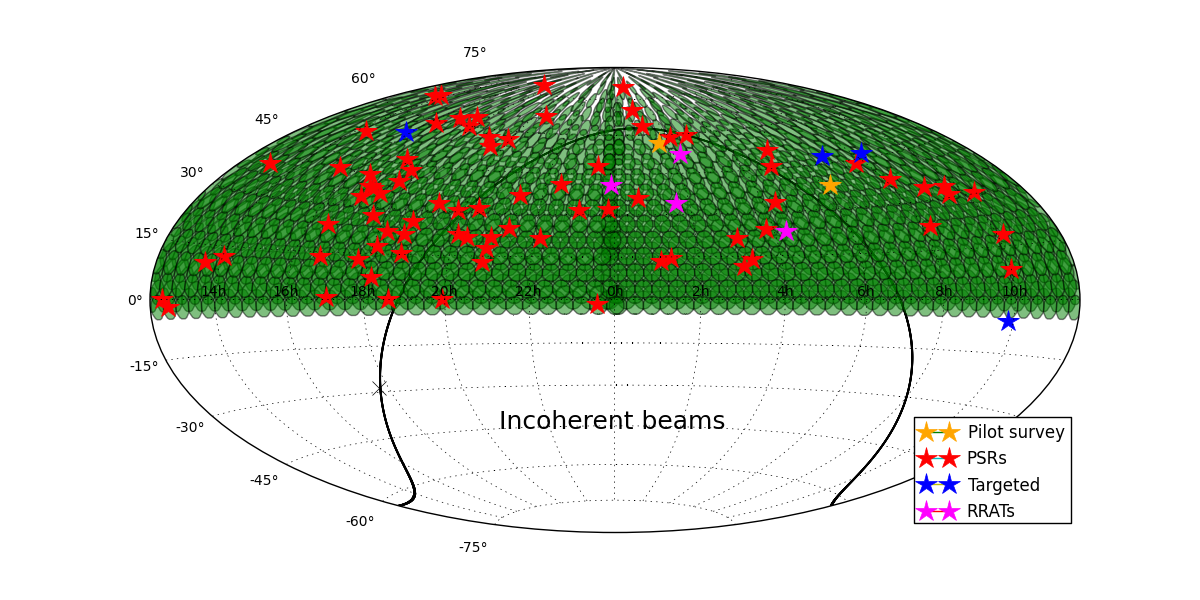 | 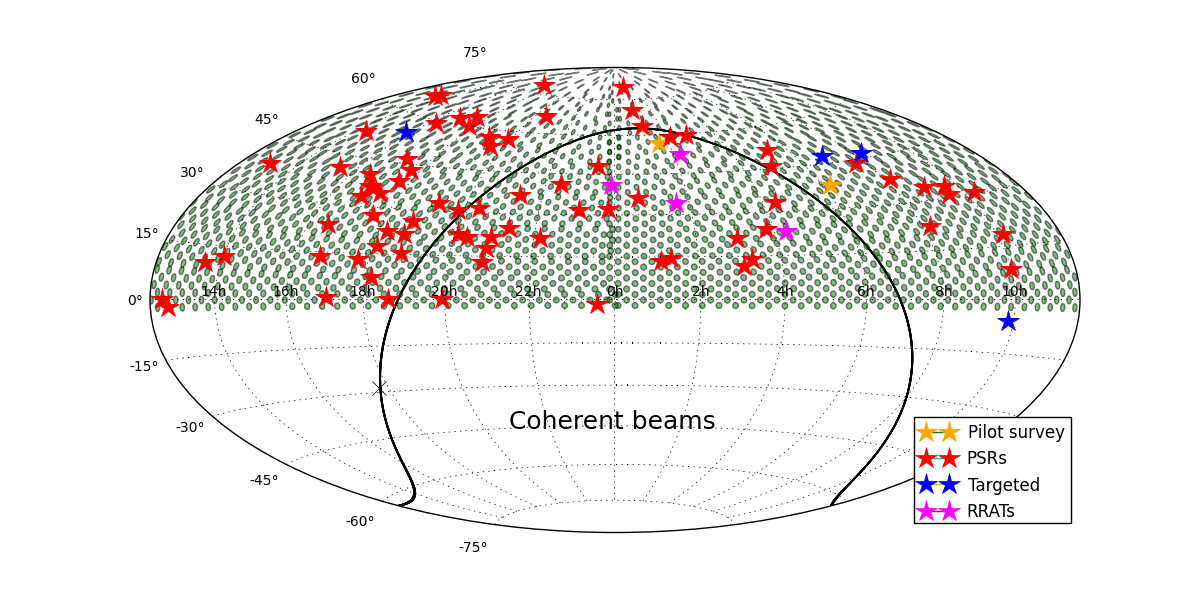 |
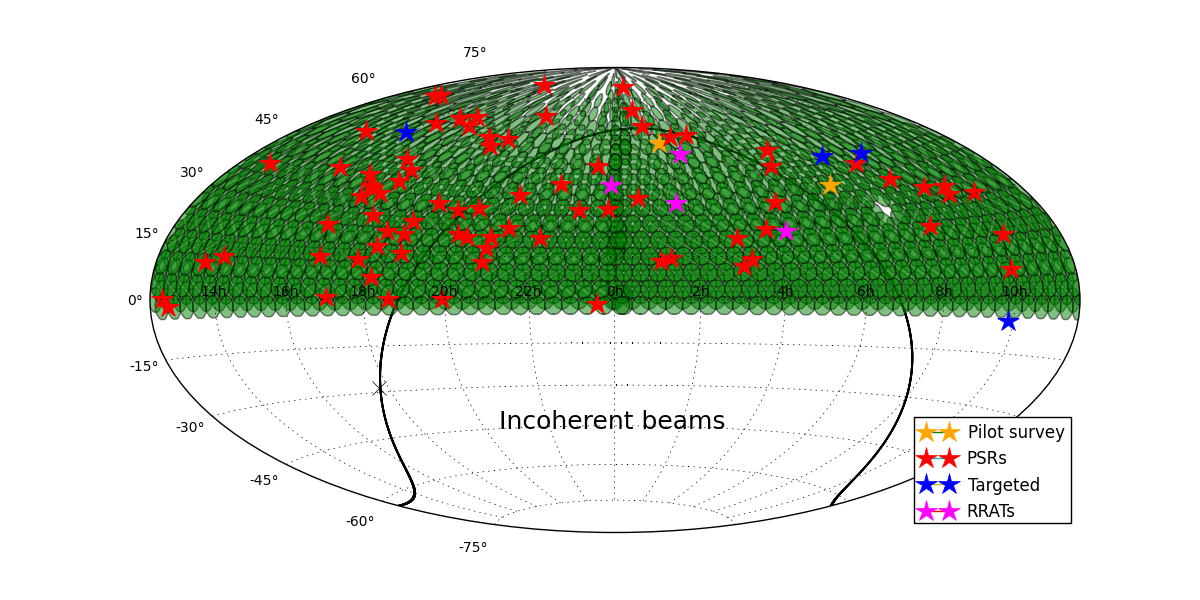 | 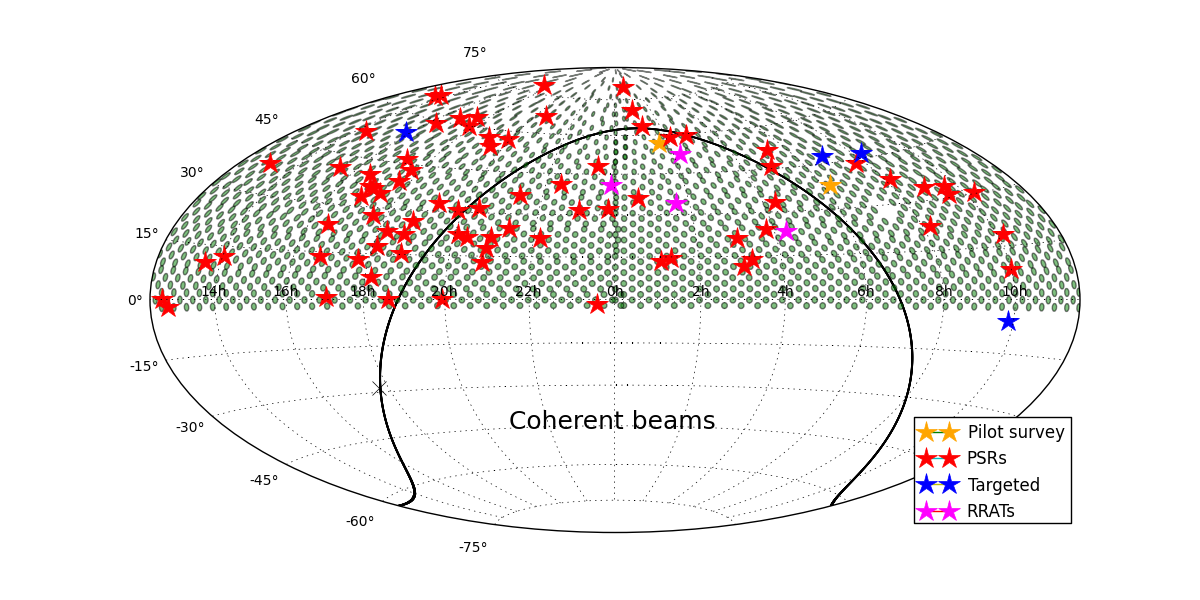 |
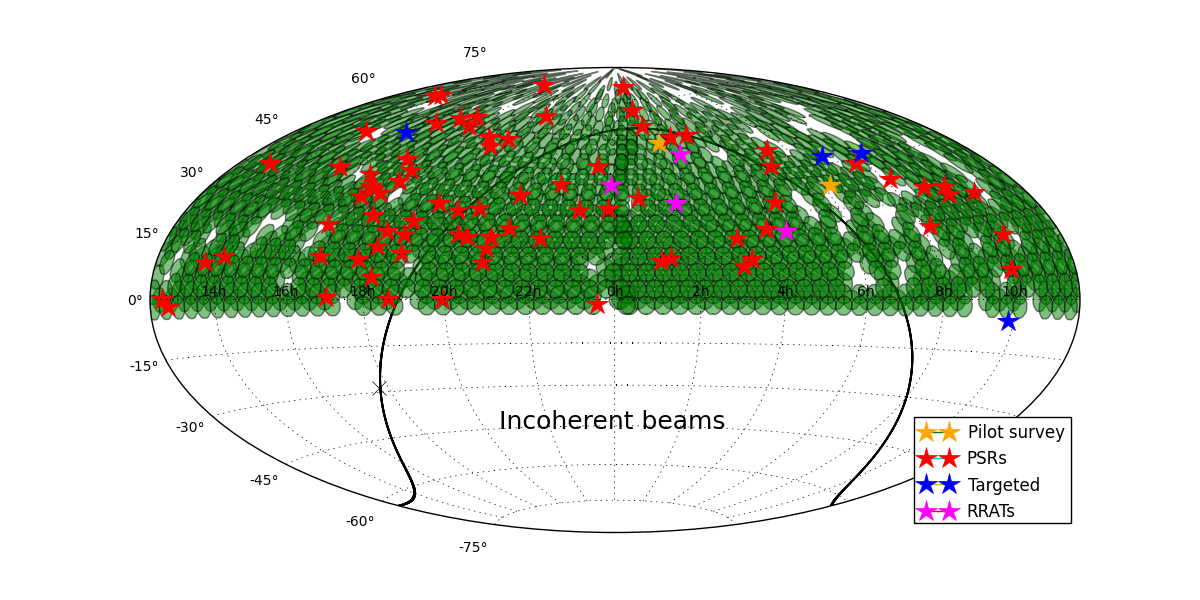 | 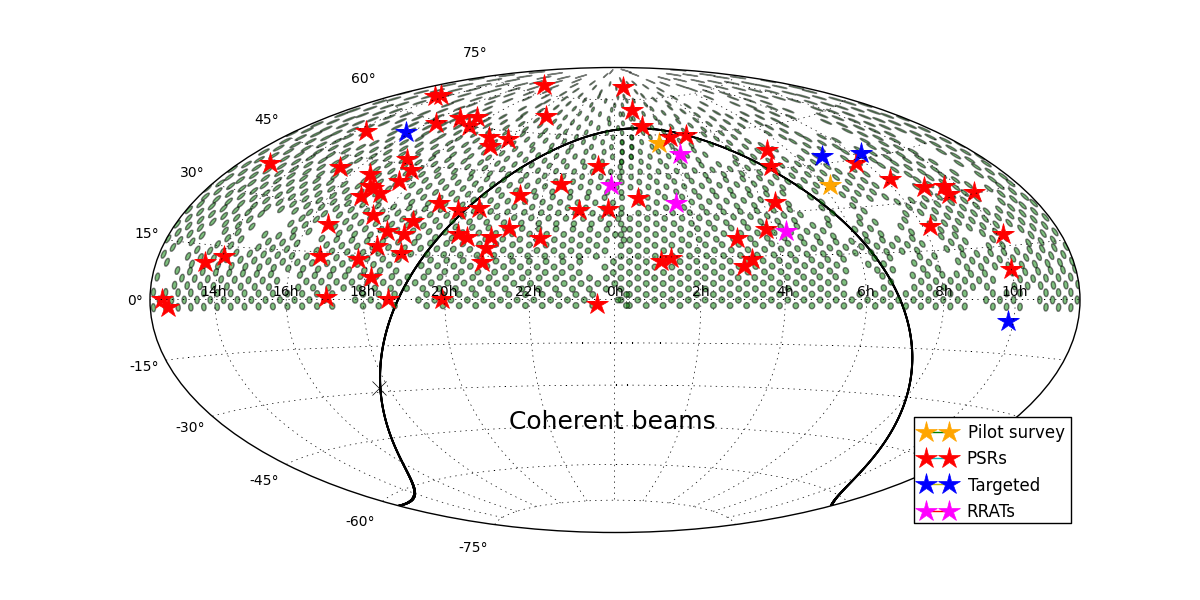 |
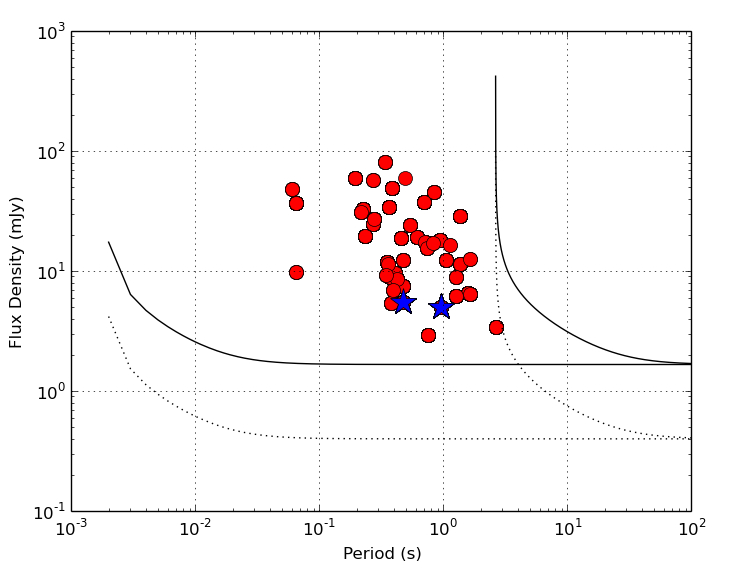
Minimum theoretical flux of Superterp at DM = 50 and DM = 300 pc/cc, for low (solid lines) and high (dashed
lines) Galactic latitudes. This includes a scattering term based on Bhat et al. (2004). The fluxes of known pulsars so far found within the
LOTAAS survey (red) and LOTAAS discoveries (blue stars) are also plotted. This shows that we are within a factor of 3 in terms of
reaching the theoretical survey sensitivity, and will have to dig deeper into our existing search candidate lists to find the weakest sources.



The research leading to these results has received funding from the European Research Council
under the European Union's Seventh Framework Programme (FP7/2007-2013) / ERC grant agreement nr. 337062 (DRAGNET; PI Hessels)
and from an NWO Vidi Fellowship (PI Hessels).